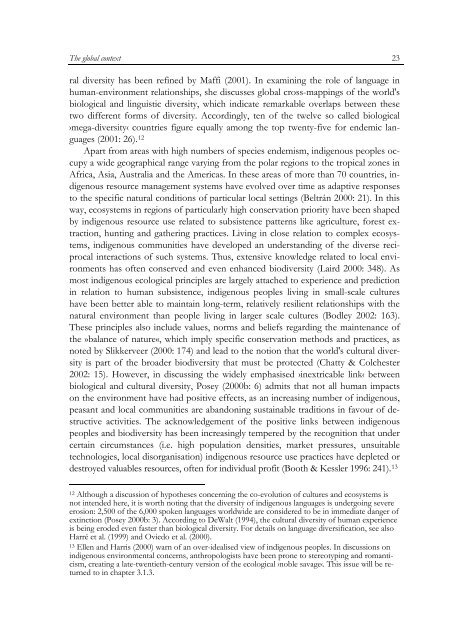The cultural context of biodiversity conservation - Oapen
The cultural context of biodiversity conservation - Oapen
The cultural context of biodiversity conservation - Oapen
You also want an ePaper? Increase the reach of your titles
YUMPU automatically turns print PDFs into web optimized ePapers that Google loves.
<strong>The</strong> global <strong>context</strong><br />
ral diversity has been refined by Maffi (2001). In examining the role <strong>of</strong> language in<br />
human-environment relationships, she discusses global cross-mappings <strong>of</strong> the world's<br />
biological and linguistic diversity, which indicate remarkable overlaps between these<br />
two different forms <strong>of</strong> diversity. Accordingly, ten <strong>of</strong> the twelve so called biological<br />
›mega-diversity‹ countries figure equally among the top twenty-five for endemic languages<br />
(2001: 26). 12<br />
Apart from areas with high numbers <strong>of</strong> species endemism, indigenous peoples occupy<br />
a wide geographical range varying from the polar regions to the tropical zones in<br />
Africa, Asia, Australia and the Americas. In these areas <strong>of</strong> more than 70 countries, indigenous<br />
resource management systems have evolved over time as adaptive responses<br />
to the specific natural conditions <strong>of</strong> particular local settings (Beltrán 2000: 21). In this<br />
way, ecosystems in regions <strong>of</strong> particularly high <strong>conservation</strong> priority have been shaped<br />
by indigenous resource use related to subsistence patterns like agriculture, forest extraction,<br />
hunting and gathering practices. Living in close relation to complex ecosystems,<br />
indigenous communities have developed an understanding <strong>of</strong> the diverse reciprocal<br />
interactions <strong>of</strong> such systems. Thus, extensive knowledge related to local environments<br />
has <strong>of</strong>ten conserved and even enhanced <strong>biodiversity</strong> (Laird 2000: 348). As<br />
most indigenous ecological principles are largely attached to experience and prediction<br />
in relation to human subsistence, indigenous peoples living in small-scale cultures<br />
have been better able to maintain long-term, relatively resilient relationships with the<br />
natural environment than people living in larger scale cultures (Bodley 2002: 163).<br />
<strong>The</strong>se principles also include values, norms and beliefs regarding the maintenance <strong>of</strong><br />
the »balance <strong>of</strong> nature«, which imply specific <strong>conservation</strong> methods and practices, as<br />
noted by Slikkerveer (2000: 174) and lead to the notion that the world's <strong>cultural</strong> diversity<br />
is part <strong>of</strong> the broader <strong>biodiversity</strong> that must be protected (Chatty & Colchester<br />
2002: 15). However, in discussing the widely emphasised ›inextricable link‹ between<br />
biological and <strong>cultural</strong> diversity, Posey (2000b: 6) admits that not all human impacts<br />
on the environment have had positive effects, as an increasing number <strong>of</strong> indigenous,<br />
peasant and local communities are abandoning sustainable traditions in favour <strong>of</strong> destructive<br />
activities. <strong>The</strong> acknowledgement <strong>of</strong> the positive links between indigenous<br />
peoples and <strong>biodiversity</strong> has been increasingly tempered by the recognition that under<br />
certain circumstances (i.e. high population densities, market pressures, unsuitable<br />
technologies, local disorganisation) indigenous resource use practices have depleted or<br />
destroyed valuables resources, <strong>of</strong>ten for individual pr<strong>of</strong>it (Booth & Kessler 1996: 241). 13<br />
12 Although a discussion <strong>of</strong> hypotheses concerning the co-evolution <strong>of</strong> cultures and ecosystems is<br />
not intended here, it is worth noting that the diversity <strong>of</strong> indigenous languages is undergoing severe<br />
erosion: 2,500 <strong>of</strong> the 6,000 spoken languages worldwide are considered to be in immediate danger <strong>of</strong><br />
extinction (Posey 2000b: 3). According to DeWalt (1994), the <strong>cultural</strong> diversity <strong>of</strong> human experience<br />
is being eroded even faster than biological diversity. For details on language diversification, see also<br />
Harré et al. (1999) and Oviedo et al. (2000).<br />
13 Ellen and Harris (2000) warn <strong>of</strong> an over-idealised view <strong>of</strong> indigenous peoples. In discussions on<br />
indigenous environmental concerns, anthropologists have been prone to stereotyping and romanticism,<br />
creating a late-twentieth-century version <strong>of</strong> the ecological ›noble savage‹. This issue will be returned<br />
to in chapter 3.1.3.<br />
23

















